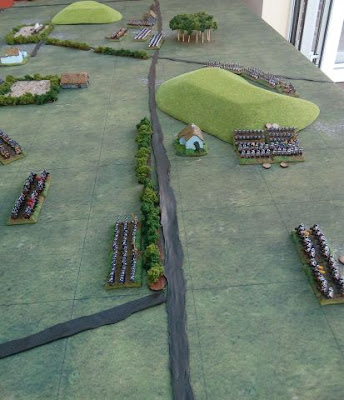The battle was a loose interpretation of the fight for the right flank of the Battle of Kolin on18th June 1757, fought between the Prussians and Austrians.
As per the real battle I place a brigade of Grenze light infantry into the rough ground and placed a brigade of Austrian German infantry to the east (right flank) of Kutlire. I placed a Grenadier Brigade with Horse Grenadier support as a central reserve.
Grenze holding the village of Kutlire
The Prussians had three Infantry brigades, one of which was elite and 4 regiments of cavalry, two cuirassier and two hussar. The two sides had roughly equal infantry but the Prussians had a cavalry advantage. The Austrians however had the advantageous terrain.
For the Prussians to win a victory they had to capture the village of Kutlire (in the centre of the table) and cut off the Austrian ability to reinforce the main Austrian Army (who are off table to the Austrian left.)
For this battle I wanted to test using one 60mm stand for each unit using the Black power rules. The scenario rules brought a SYW flavour to the battle. Click on the link for the unit stats for the armies.
Austrians are on the left of the pictures, Prussians the right.
The battle started with the Prussian Cuirassiers making a huge flanking movement (triple move) around the Austrian right flank, the Prussian left advancing and the rest of the army going backwards (blunder) or standing still.
In the second turn the Cuirassiers charged into the flank of one Austrian battalion driving them back and then charging and driving back a second battalion before retiring themselves in good order. The infantry on the Prussian left advanced to point blank range and opened fire to little effect.
Cuirassiers charge home on the Austrian right flank
The fight on the Prussian left was not going well for the Austrians., The Prussians occupied half of the village. Meanwhile on the Prussian right flank their Elite brigade continued to refuse to advance and instead swapped a few shots with the Austrian Grenze.
Austrian infantry brigade starts to break
It was time for the Austrian reserves...
Austrian Grenadiers and Horse Grenadiers
The Austrian reserve marched to the relief of the right wing. During the ensuing fight, a unit of Horse Grenadiers charged the Prussian infantry brigade occupying half of the village. Heavy cavalry v 3 battalions in line, what could go wrong...so that was the end of that regiment. A similar lesson on the Prussian side was an infantry battalion bayonet charging a battery of artillery...so that was the end of that battalion. In the end the Austrian reserve managed to drive back the Prussian assault.
However the Prussian elite brigate had managed to drive the Grenze off the high ground and force them back into the woods.
Grenze in the woods, Prussians on the high ground
This gave the Prussians the high grounds overlooking the half of Kutlire village still held by the Austrians but the light was beginning to fail. The Prussians had time for one assault on the village. If they captured the village it would be a Prussian victory. If they failed an Austrian victory...
The Assault!
The Elite Prussian forces fought hard but Austrian Grenze defencing the high walls of the fortified farm house held on. Darkness fell over an Austrian victory.
After Action Thoughts
- It was a great game. I though the battle was all but over in the second turn when the Prussian Cuirassiers flank charged the Austrian right.
- Using one 60mm base per battalion or cavalry unit worked very well. It allow for manoeuvring room on the table (6'x4'). Due to the period it's not so important that we can't depict columns and squares as easily as you can with multiple bases.
- The Black power rules are fun and we are getting quicker to play them as we become more familiar with them.
- One change we will make if to bring in a rule similar to that suggested in Age of Eagles where Cavalry may opt to charge any unit, to their front, moving into proximity range (12cm). The rule will allow infantry more move into musket range without provoking a charge but closing to point blank range may provoke a charge.
- I personally got a great kick out of refighting part of an actual battle, even if it was a loose interpretation. In hindsight maybe I should have given the Prussians more troops to offset the advantage of the Austrians starting in the village but I'm not sure that would have helped them. The main reason the Prussians lost was their inability to get their Elite troops up onto the high ground to attack Kutlire until the last turn of the game.
















































